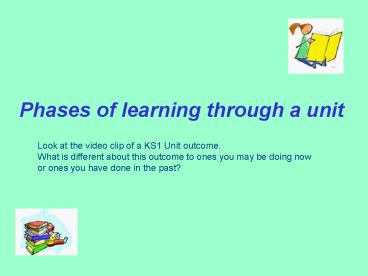Phases of learning through a unit - PowerPoint PPT Presentation
1 / 10
Title:
Phases of learning through a unit
Description:
Freeze framing each doodle. Role play. Thought tracking. Small world play ... Doodling Daniel. Visual, oral, aural support. Thought showering new ideas ... – PowerPoint PPT presentation
Number of Views:100
Avg rating:3.0/5.0
Title: Phases of learning through a unit
1
Phases of learning through a unit
Look at the video clip of a KS1 Unit
outcome. What is different about this outcome to
ones you may be doing now or ones you have done
in the past?
2
Planning and the Renewed Framework
- Based on findings from the work of Eve Bearne,
- and action research by practitioners
- Developing practice from coverage within fixed
- time frames to more flexible learning sequences
- based on AfL
- Planning model underpins the role of the renewed
- framework in raising standards
3
Developing the Model
- Planning model developed through action research
with leading practitioners from around the
country - Planning in phases of learning within meaningful
contexts found to have a significant impact on
standards in writing in 71.5 of the sample,
writing levels had improved by one third of a
level or above in the course of one term. - Main findings were summarised in the UKLA/PNS
publication Raising boys achievement in writing
4
Underpinning Principles
- Learning and Teaching
- Firmly based on AfL
- Has a clear outcome and purpose
- Works through a sequence of phases to support
learning - Provides time for children to explore and respond
to texts - Provides time for children to experience and
engage in the writing process - Provides time for children to plan
collaboratively and as individuals - Speaking and listening is integral to the
learning - Utilises modelled, shared, guided and supported
approaches to scaffold learning
5
Phases of the Planning Model
6
Doodling Daniel Visual, oral, aural support
Scary music Doodles translated into
other languages Freeze framing each doodle Role
play Thought tracking Small world play Images of
islands/different fantasy settings
Thought showering new ideas Sequencing
story Story circle Mind maps Story maps Role play
and freeze frame Digital images of children to
capture role play
Peer conferencing Response partners 3 stars and a
wish Working wall Success criteria for
writing Using images of children onto different
settings ICT
7
Suggested teaching sequence
8
Planning a unit Year 1 Narrative unit 4
Shared reading Read, compare and contrast a range
of fantasy world settings from different text
sources. Identify objects found in the settings
that make them different from the world around
us. Create fantasy settings using knowledge from
shared reading.
Role-play and idea generation Orally compose an
adventure narrative. Drama techniques and digital
photographs enable children to record their ideas
and develop the pattern of conflict and
resolution in a narrative.
Writing Model the use of visual plans to support
writing. Apply sentence-level skills developed in
previous guided sessions. Compose adventures in
fantasy settings applying the concept of problem
and resolution using interactive whiteboard (IWB)
software.
Children assess extent to which they have met
learning outcomes after each phase
9
- TASK
- Look at a unit of work in year groups.
- On sugar paper
- Show the phases of learning for your unit.
- An overview of what is contained in each phase.
- How many days for each phase?
- What are the outcomes for each phase
- What oral, aural and visual support may be
included. - Be prepared to report back to the rest of the
group.
10
(No Transcript)































